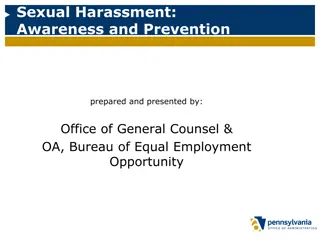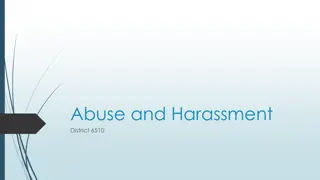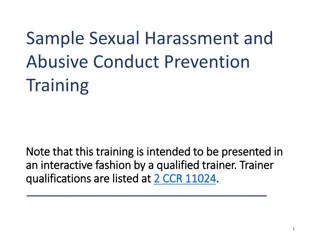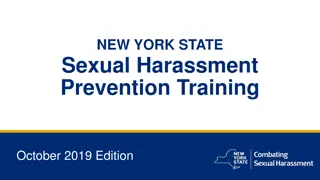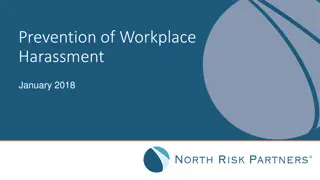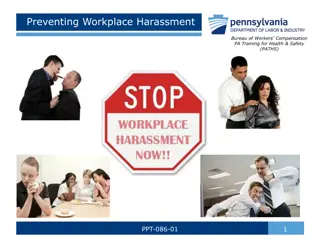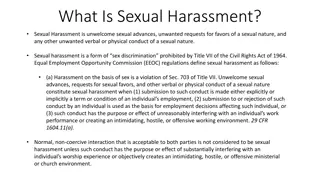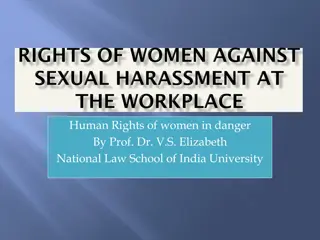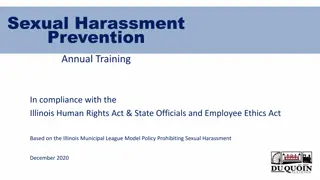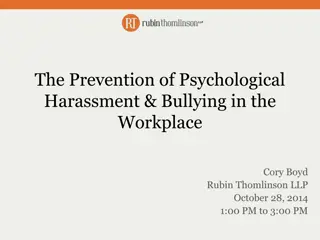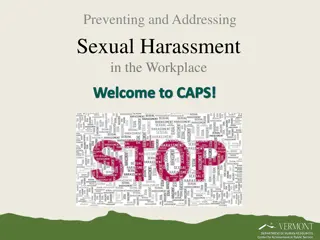Comprehensive Sexual Harassment Prevention Training Overview
This presentation provides a detailed overview of sexual harassment prevention training for employees, covering important topics such as recognizing sexual harassment, understanding company policies and procedures, and outlining employee responsibilities. It explains the different forms of sexual harassment, including quid pro quo and hostile work environments, and emphasizes the importance of creating a safe and respectful workplace environment.
Download Presentation

Please find below an Image/Link to download the presentation.
The content on the website is provided AS IS for your information and personal use only. It may not be sold, licensed, or shared on other websites without obtaining consent from the author.If you encounter any issues during the download, it is possible that the publisher has removed the file from their server.
You are allowed to download the files provided on this website for personal or commercial use, subject to the condition that they are used lawfully. All files are the property of their respective owners.
The content on the website is provided AS IS for your information and personal use only. It may not be sold, licensed, or shared on other websites without obtaining consent from the author.
E N D
Presentation Transcript
Sexual Harassment Prevention Training for Employees
Sexual Harassment Prevention Training for Employees WELCOME! 2
Introduction Sexual harassment training is not required under federal law. However, many states have enacted legislation specifically requiring sexual harassment training. Even if not required in a state, the Supreme Court's landmark decisions in the 1998 Faragher and Ellerth sexual harassment cases, subsequent court decisions, and Equal Employment Opportunity Commission (EEOC) guidelines make it clear that sexual harassment training is essential. This presentation provides you with information on how to recognize sexual harassment and reviews our company policy and procedure on responding to and reporting sexual harassment concerns. 3
Agenda What is sexual harassment? Why it is important to prevent sexual harassment in our workplace? Our policy and procedure on sexual harassment. Your responsibilities. 4
What Is Sexual Harassment? Unwelcome sexual advances. Requests for sexual favors. Other verbal, written, electronic or physical conduct of a sexual nature that affects an individual s employment, unreasonably interferes with his or her work performance, or creates an intimidating, hostile or offensive work environment. 5
What Is Sexual Harassment? (cont.) The two forms of sexual harassment are: 1. Quid pro quo (Latin for this for that or something for something ). 2. Hostile work environment. 6
What Is Sexual Harassment? (cont.) Quid Pro Quo: Tangible employment action against the victim. Involves monetary loss or change in job. Example: Yvette receives a smaller performance-based pay increase than other employees with similar performance because she refused to go on a date with her supervisor, Marcus. 7
What Is Sexual Harassment? (cont.) Hostile Work Environment: Speech or conduct that is severe and/or pervasive enough to create an abusive or hostile work environment. Example: Max is leering at and intentionally brushing against Vanessa. 8
What is Sexual Harassment? (cont.) Hostile Work Environment (cont.) In addition to speech and/or conduct, hostile work environment covers explicit or suggestive items that are e-mailed, texted, electronically provided or displayed in the workplace that interfere with job performance or that create an abusive or hostile work environment. Example: Maria texts and instant messages her co-workers with sexually explicit jokes and pictures. 9
What is Sexual Harassment? (cont.) Who can commit sexual harassment? Employees at all levels. Customers or vendors. Members of the same sex or opposite sex. Who can be a victim of sexual harassment? Individual or individuals targeted by statements or actions. Bystanders or witnesses not directly targeted 10
Why It Is Important to Prevent Sexual Harassment in Our Workplace Sexual harassment harms us all. The most important part of our corporate values is to ensure all employees are treated with respect and dignity. Engaging in, condoning or not reporting sexual harassment is in direct conflict with our values. We want to remain in compliance with Title VII of the Civil Rights Act, which prohibits sex discrimination (including sexual orientation and gender identity or expression). We want to remain in compliance with similar state civil rights laws and fair employment laws. 12
Our Policy and Procedure on Sexual Harassment 14
Your Responsibilities Know and comply with our policy and procedure. Report incidents that you experience directly or witness. Cooperate with investigations. Support victims. 16
Summary Sexual harassment is unwelcome sexual advances, requests for sexual favors and other verbal, written, electronic or physical conduct of a sexual nature that affects an individual s employment, unreasonably interferes with his or her work performance or creates an intimidating, hostile or offensive work environment. 18
Summary (cont.) There are two forms of sexual harassment: quid pro quo and hostile work environment. It is important to prevent sexual harassment in our workplace because it harms us all. It conflicts with our corporate value that all employees are treated with respect and dignity. 19
Summary (cont.) Sexual harassment is illegal under federal and state laws. Your responsibilities regarding prevention of sexual harassment are to know and comply with our policy and procedure, report incidents that you experience directly or witness, cooperate with investigations, and support victims. 20
Training Evaluation Please complete the training evaluation sheet included in the handouts. Thank you for your interest and attention! 22






